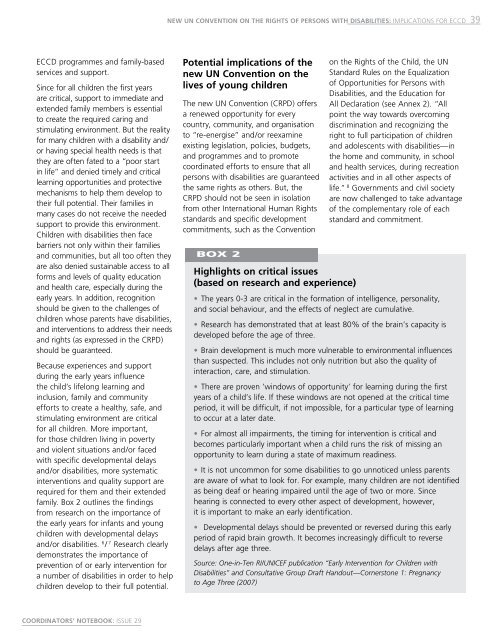A global call to action for early childhood
A global call to action for early childhood
A global call to action for early childhood
You also want an ePaper? Increase the reach of your titles
YUMPU automatically turns print PDFs into web optimized ePapers that Google loves.
New UN Convention on the Rights of Persons with Disabilities: Implications <strong>for</strong> ECCD<br />
39<br />
ECCD programmes and family-based<br />
services and support.<br />
Since <strong>for</strong> all children the first years<br />
are critical, support <strong>to</strong> immediate and<br />
extended family members is essential<br />
<strong>to</strong> create the required caring and<br />
stimulating environment. But the reality<br />
<strong>for</strong> many children with a disability and/<br />
or having special health needs is that<br />
they are often fated <strong>to</strong> a “poor start<br />
in life” and denied timely and critical<br />
learning opportunities and protective<br />
mechanisms <strong>to</strong> help them develop <strong>to</strong><br />
their full potential. Their families in<br />
many cases do not receive the needed<br />
support <strong>to</strong> provide this environment.<br />
Children with disabilities then face<br />
barriers not only within their families<br />
and communities, but all <strong>to</strong>o often they<br />
are also denied sustainable access <strong>to</strong> all<br />
<strong>for</strong>ms and levels of quality education<br />
and health care, especially during the<br />
<strong>early</strong> years. In addition, recognition<br />
should be given <strong>to</strong> the challenges of<br />
children whose parents have disabilities,<br />
and interventions <strong>to</strong> address their needs<br />
and rights (as expressed in the CRPD)<br />
should be guaranteed.<br />
Because experiences and support<br />
during the <strong>early</strong> years influence<br />
the child’s lifelong learning and<br />
inclusion, family and community<br />
ef<strong>for</strong>ts <strong>to</strong> create a healthy, safe, and<br />
stimulating environment are critical<br />
<strong>for</strong> all children. More important,<br />
<strong>for</strong> those children living in poverty<br />
and violent situations and/or faced<br />
with specific developmental delays<br />
and/or disabilities, more systematic<br />
interventions and quality support are<br />
required <strong>for</strong> them and their extended<br />
family. Box 2 outlines the findings<br />
from research on the importance of<br />
the <strong>early</strong> years <strong>for</strong> infants and young<br />
children with developmental delays<br />
and/or disabilities. 6 / 7 Research cl<strong>early</strong><br />
demonstrates the importance of<br />
prevention of or <strong>early</strong> intervention <strong>for</strong><br />
a number of disabilities in order <strong>to</strong> help<br />
children develop <strong>to</strong> their full potential.<br />
Potential implications of the<br />
new UN Convention on the<br />
lives of young children<br />
The new UN Convention (CRPD) offers<br />
a renewed opportunity <strong>for</strong> every<br />
country, community, and organisation<br />
<strong>to</strong> “re-energise” and/or reexamine<br />
existing legislation, policies, budgets,<br />
and programmes and <strong>to</strong> promote<br />
coordinated ef<strong>for</strong>ts <strong>to</strong> ensure that all<br />
persons with disabilities are guaranteed<br />
the same rights as others. But, the<br />
CRPD should not be seen in isolation<br />
from other International Human Rights<br />
standards and specific development<br />
commitments, such as the Convention<br />
BOX 2<br />
Highlights on critical issues<br />
(based on research and experience)<br />
on the Rights of the Child, the UN<br />
Standard Rules on the Equalization<br />
of Opportunities <strong>for</strong> Persons with<br />
Disabilities, and the Education <strong>for</strong><br />
All Declaration (see Annex 2). “All<br />
point the way <strong>to</strong>wards overcoming<br />
discrimination and recognizing the<br />
right <strong>to</strong> full participation of children<br />
and adolescents with disabilities—in<br />
the home and community, in school<br />
and health services, during recreation<br />
activities and in all other aspects of<br />
life.” 8 Governments and civil society<br />
are now challenged <strong>to</strong> take advantage<br />
of the complementary role of each<br />
standard and commitment.<br />
• The years 0-3 are critical in the <strong>for</strong>mation of intelligence, personality,<br />
and social behaviour, and the effects of neglect are cumulative.<br />
• Research has demonstrated that at least 80% of the brain’s capacity is<br />
developed be<strong>for</strong>e the age of three.<br />
• Brain development is much more vulnerable <strong>to</strong> environmental influences<br />
than suspected. This includes not only nutrition but also the quality of<br />
inter<strong>action</strong>, care, and stimulation.<br />
• There are proven ’windows of opportunity’ <strong>for</strong> learning during the first<br />
years of a child’s life. If these windows are not opened at the critical time<br />
period, it will be difficult, if not impossible, <strong>for</strong> a particular type of learning<br />
<strong>to</strong> occur at a later date.<br />
• For almost all impairments, the timing <strong>for</strong> intervention is critical and<br />
becomes particularly important when a child runs the risk of missing an<br />
opportunity <strong>to</strong> learn during a state of maximum readiness.<br />
• It is not uncommon <strong>for</strong> some disabilities <strong>to</strong> go unnoticed unless parents<br />
are aware of what <strong>to</strong> look <strong>for</strong>. For example, many children are not identified<br />
as being deaf or hearing impaired until the age of two or more. Since<br />
hearing is connected <strong>to</strong> every other aspect of development, however,<br />
it is important <strong>to</strong> make an <strong>early</strong> identification.<br />
• Developmental delays should be prevented or reversed during this <strong>early</strong><br />
period of rapid brain growth. It becomes increasingly difficult <strong>to</strong> reverse<br />
delays after age three.<br />
Source: One-in-Ten RI/UNICEF publication “Early Intervention <strong>for</strong> Children with<br />
Disabilities” and Consultative Group Draft Handout—Corners<strong>to</strong>ne 1: Pregnancy<br />
<strong>to</strong> Age Three (2007)<br />
COORDINATORS’ NOTEBOOK: ISSUE 29
















